Air Conditioning Compressor Replacement 4.3, 5.0 and 5.7L Engines
Removal Procedure
Caution: Unless directed otherwise, the ignition and start switch must be in the OFF or LOCK position, and all electrical loads must be OFF before servicing any electrical component. Disconnect the negative battery cable to prevent an electrical spark should a tool or equipment come in contact with an exposed electrical terminal. Failure to follow these precautions may result in personal injury and/or damage to the vehicle or its components.
- Disconnect the battery negative cable. Refer to Battery Negative Cable Disconnection and Connection in Engine Electrical.
- Remove the air cleaner assembly. Refer to Air Cleaner Assembly Replacement 4.3L or Air Cleaner Assembly Replacement 5.0/5.7L in Engine Controls.
- Recover the refrigerant from the system. Refer to Refrigerant Recovery and Recharging .
- Disconnect the clutch coil electrical connector (1) from the compressor.
- Disconnect the high pressure switch electrical connector (2) from the compressor.
- Remove the drive belt. Refer to Drive Belt Replacement 4.3L or Drive Belt Replacement 5.0/ 5.7L in Engine Mechanical.
- Remove the compressor (3) and the condenser hose assembly. Refer to Compressor Hose Assembly Replacement .
- Remove the compressor to the mounting bracket bolts.
- Remove the compressor from the vehicle.
- Drain and measure the compressor oil.
- Check the oil for metal or discoloration. If metal is found replace the expansion orifice tube. Refer to Expansion (Orifice) Tube Replacement .
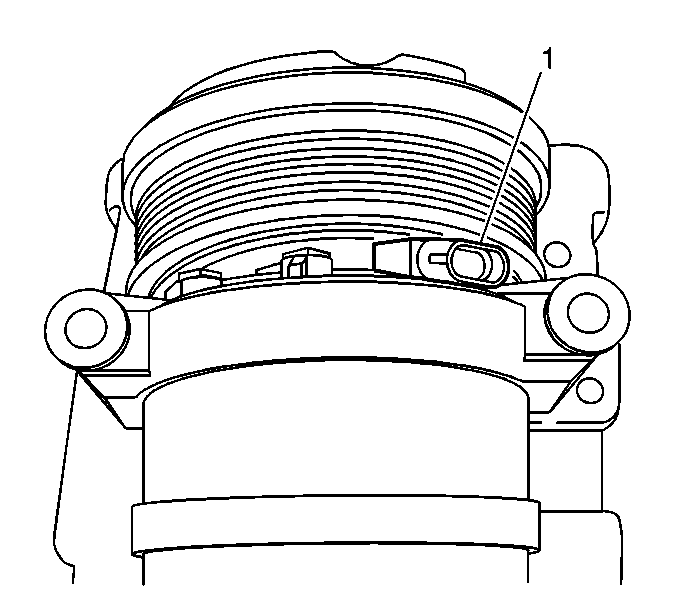
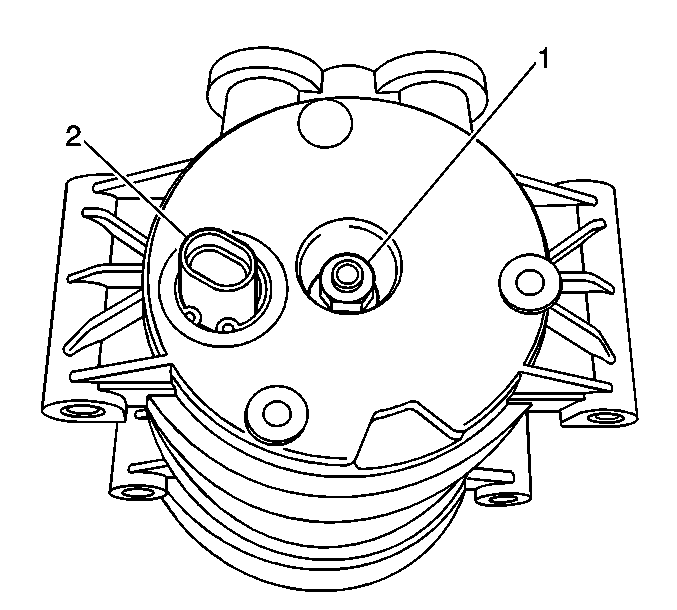
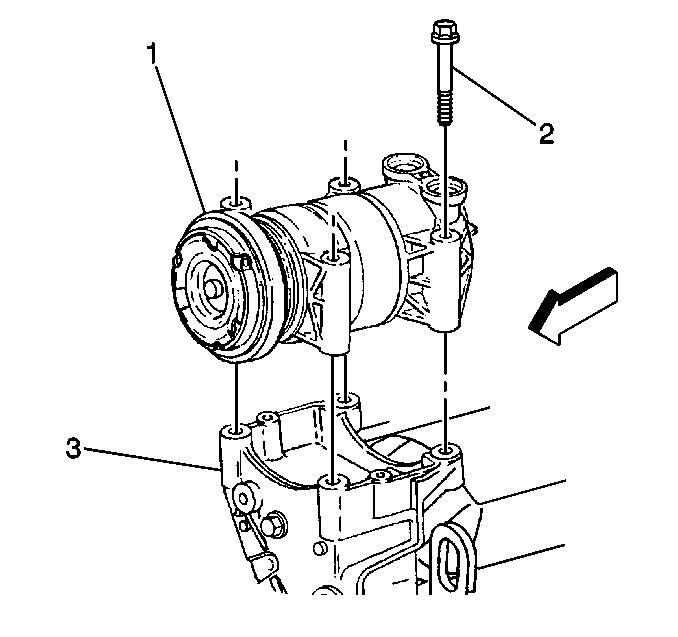
Installation Procedure
- Install the compressor (3) to the vehicle.
- Add oil to the compressor. Refer to Refrigerant Oil Distribution , if replacing the compressor.
- Install the compressor retaining bolts to the mounting bracket.
- Install the compressor and the condenser hose assembly. Refer to Compressor Hose Assembly Replacement .
- Install the drive belt. Refer to Drive Belt Replacement 4.3L or Drive Belt Replacement 5.0/ 5.7L in Engine Mechanical.
- Connect the clutch coil electrical connector (1) to the compressor.
- Connect the high pressure switch electrical connector (2) from the compressor.
- Install the air cleaner assembly. Refer to Air Cleaner Assembly Replacement 4.3L or Air Cleaner Assembly Replacement 5.0/5.7L in Engine Controls.
- Install the battery negative cable. Refer to Battery Disconnect Caution in Engine Electrical.
- Evacuate and Recharge the refrigerant to the system. Refer to Refrigerant Recovery and Recharging .
- Inspect the system for leaks. Refer to Leak Testing .

Important: The compressor is shipped without oil.
Notice: Use the correct fastener in the correct location. Replacement fasteners must be the correct part number for that application. Fasteners requiring replacement or fasteners requiring the use of thread locking compound or sealant are identified in the service procedure. Do not use paints, lubricants, or corrosion inhibitors on fasteners or fastener joint surfaces unless specified. These coatings affect fastener torque and joint clamping force and may damage the fastener. Use the correct tightening sequence and specifications when installing fasteners in order to avoid damage to parts and systems.
Tighten
Tighten the bolts to 50 N·m (37 lb ft).


Air Conditioning Compressor Replacement 7.4L
Removal Procedure
- Remove the battery negative cable. Refer to Battery Negative Cable Disconnection and Connection in Engine Electrical.
- Remove the air cleaner assembly. Refer to Air Cleaner Assembly Replacement in Engine Controls.
- Recover the refrigerant from the system. Refer to Refrigerant Recovery and Recharging .
- Disconnect the clutch coil electrical connector (1) from the compressor.
- Disconnect the high pressure switch electrical connector (2) from the compressor.
- Remove the drive belt. Refer to Drive Belt Replacement in Engine Mechanical.
- Remove the compressor (3) and the condenser hose assembly. Refer to Compressor Hose Assembly Replacement .
- Remove the compressor to the mounting bracket bolts.
- Remove the compressor from the vehicle.
- Drain and measure the compressor oil.
- Check the oil for metal or discoloration. If metal is found replace the expansion orifice tube. Refer to Expansion (Orifice) Tube Replacement .
Caution: Unless directed otherwise, the ignition and start switch must be in the OFF or LOCK position, and all electrical loads must be OFF before servicing any electrical component. Disconnect the negative battery cable to prevent an electrical spark should a tool or equipment come in contact with an exposed electrical terminal. Failure to follow these precautions may result in personal injury and/or damage to the vehicle or its components.


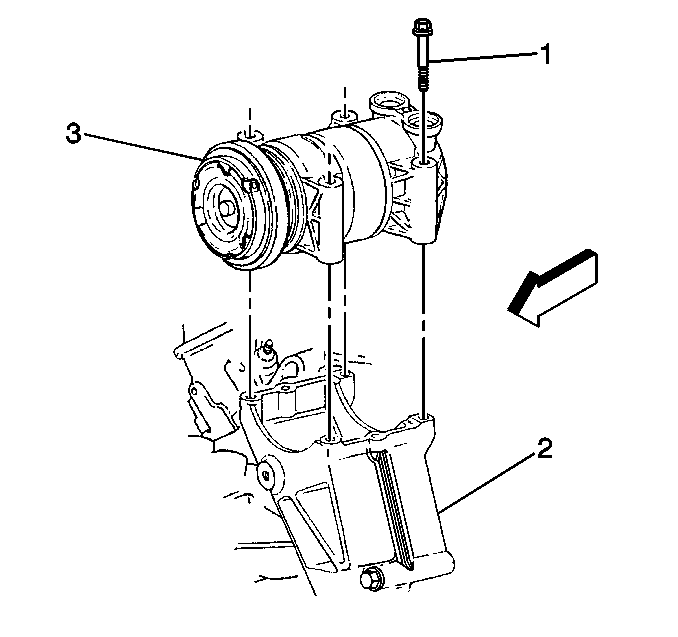
Installation Procedure
- Install the compressor (3) to the vehicle.
- Add oil to the compressor. Refer to Refrigerant Oil Distribution , if replacing the compressor.
- Install the compressor retaining bolts to the mounting bracket.
- Install the compressor and the condenser hose assembly. Refer to Compressor Hose Assembly Replacement .
- Install the drive belt. Refer to Drive Belt Replacement in Engine Mechanical.
- Connect the clutch coil electrical connector (1) to the compressor.
- Connect the high pressure switch electrical connector (2) from the compressor.
- Install the air cleaner assembly. Refer to Air Cleaner Assembly Replacement in Engine Controls.
- Connect the battery negative cable.
- Evacuate and Recharge the refrigerant to the system. Refer to Refrigerant Recovery and Recharging .
- Inspect the system for leaks. Refer to Leak Testing .

Important: The compressor is shipped without oil.
Notice: Use the correct fastener in the correct location. Replacement fasteners must be the correct part number for that application. Fasteners requiring replacement or fasteners requiring the use of thread locking compound or sealant are identified in the service procedure. Do not use paints, lubricants, or corrosion inhibitors on fasteners or fastener joint surfaces unless specified. These coatings affect fastener torque and joint clamping force and may damage the fastener. Use the correct tightening sequence and specifications when installing fasteners in order to avoid damage to parts and systems.
Tighten
Tighten the bolts to 50 N·m (37 lb ft).


Caution: Unless directed otherwise, the ignition and start switch must be in the OFF or LOCK position, and all electrical loads must be OFF before servicing any electrical component. Disconnect the negative battery cable to prevent an electrical spark should a tool or equipment come in contact with an exposed electrical terminal. Failure to follow these precautions may result in personal injury and/or damage to the vehicle or its components.
Air Conditioning Compressor Replacement 6.5L Diesel
Removal Procedure
- Disconnect the battery negative cable. Refer to Battery Negative Cable Disconnection and Connection in Engine Electrical.
- Remove the air cleaner assembly. Refer to Air Cleaner Assembly Replacement in Engine Controls.
- Recover the refrigerant from the system. Refer to Refrigerant Recovery and Recharging .
- Disconnect the clutch coil electrical connector (1) from the compressor.
- Disconnect the high pressure switch electrical connector (2) from the compressor.
- Remove the drive belt. Refer to Drive Belt Replacement in Engine Mechanical.
- Remove the compressor (1) and the condenser hose assembly. Refer to Compressor Hose Assembly Replacement .
- Remove the mounting bolts to the compressor .
- Remove the compressor from the vehicle.
- Drain and measure the compressor oil.
- Check the oil for metal or discoloration. If metal is found replace the expansion orifice tube. Refer to Expansion (Orifice) Tube Replacement .
Caution: Unless directed otherwise, the ignition and start switch must be in the OFF or LOCK position, and all electrical loads must be OFF before servicing any electrical component. Disconnect the negative battery cable to prevent an electrical spark should a tool or equipment come in contact with an exposed electrical terminal. Failure to follow these precautions may result in personal injury and/or damage to the vehicle or its components.


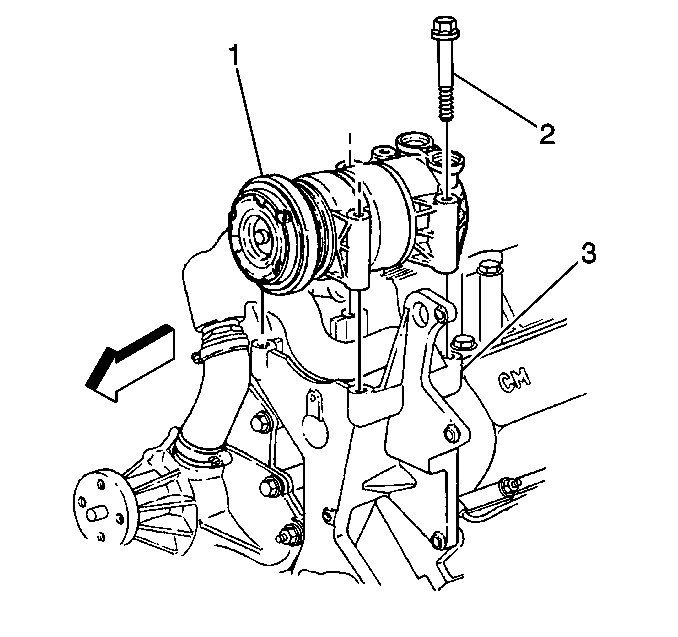
Installation Procedure
- Install the compressor (1) to the vehicle.
- Add oil to the A/C compressor. Refer to Refrigerant Oil Distribution , if replacing the compressor.
- Install the compressor retaining bolts to the mounting bracket.
- Install the compressor and the condenser hose assembly. Refer to Compressor Hose Assembly Replacement .
- Install the drive belt. Refer to Drive Belt Replacement in Engine Mechanical.
- Connect the clutch coil electrical connector (1) to the compressor.
- Connect the high pressure switch electrical connector (2) to the compressor.
- Install the air cleaner assembly. Refer to Air Cleaner Assembly Replacement in Engine Controls.
- Install the battery negative cable. Refer to Battery Disconnect Caution in Engine Electrical.
- Evacuate and Recharge the refrigerant to the system. Refer to Refrigerant Recovery and Recharging .
- Inspect the system for leaks. Refer to Leak Testing .

Important: The compressor is shipped without oil.
Notice: Use the correct fastener in the correct location. Replacement fasteners must be the correct part number for that application. Fasteners requiring replacement or fasteners requiring the use of thread locking compound or sealant are identified in the service procedure. Do not use paints, lubricants, or corrosion inhibitors on fasteners or fastener joint surfaces unless specified. These coatings affect fastener torque and joint clamping force and may damage the fastener. Use the correct tightening sequence and specifications when installing fasteners in order to avoid damage to parts and systems.
Tighten
Tighten the bolts to 50 N·m (37 lb ft).


